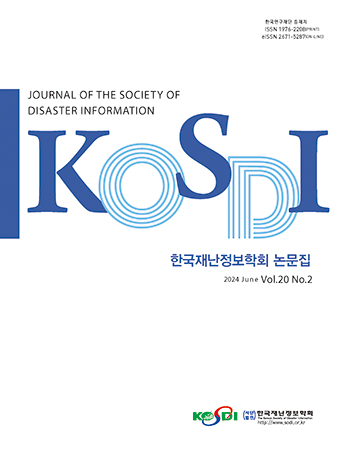Original Article
Abstract
References
Information
Purpose: This experimental study was conducted to find out whether a water-mist fire suppression system can be applied to C.E.P., a representative combustible material of a rack storage. Method: First, it was confirmed whether the water-mist fire-extinguishing system used in this experiment was capable of extinguishing oil fires. After that, the C.E.P. boxes were loaded in the same small space as used in the oil fire experiment, and then the experiment was conducted on three scenarios; door opening, door closing, and door closing and increasing the internal load. The scenario was set considering the opening and space size conditions, which are important factors for the water-mist fire suppression. Result: Oil fire suppression tests have shown that fires are well extinguished in both the door open and closed conditions. In case of a fire of C.E.P. boxes in the same space condition as an oil fire, the fire was not extinguished in the door open condition. Fires were extinguished in the case with the door closed condition, but the afterglow was confirmed. Conclusion: In the oil fire suppression test, a water-mist fire suppression system extinguished a fire in both the door open and closed conditions. However, for the C.E.P fire, it was possible to extinguish only under the door closed condition, and there was a possibility of re-ignition.
연구목적: 랙크식 창고의 대표적 가연물인 CEP에 대하여 미분무 소화설비의 적용성을 알아보기 위하여 본 실험적 연구를 수행하였다. 연구방법: 먼저 본 실험에 사용된 미분무수 소화설비가 유류화재 소화가 가능한지 확인을 수행하였다. 그 후, CEP 박스를 유류화재실험과 동일한 소규모 공간에 적재한 후, 개구부의 열림 및 닫힘, 그리고 닫힘 상태에서의 내부 적재물을 증가시키는 3가지 시나리오를 대상으로 실험을 수행하였다. 시나리오는 미분무수 소화에 중요한 영향요소인 개구부와 공간크기조건을 고려하여 설정되었다. 연구결과: 유류화재에 대한 소화시험에서는 문의 열림과 닫힘 상태, 모두에서 화재가 잘 진압되는 것으로 나타났다. 동일 공간조건에서 CEP 가연물의 화재 시 개구부의 열림 상태에서는 화재가 진압되지 않았다. 개구부를 닫은 경우 화재는 진압되었지만, 일부 잔염이 확인되었다. 결론: 유류화재 진압실험에서 미분무수 소화설비가 개구부 열림과 닫힘 상황 모두에서 유효한 소화능력을 보여주었다. 하지만 CEP화재에 대해서는 닫힘 상태에서만 유효한 소화능력을 보여주었으며, 재 발화의 가능성이 있음이 나타났다.
- FMDS 8-9 Loss Prevention Data Sheets (2015). Storage of Class 1, 2, 3, 4 AND PLASTIC COMMODITIS, pp. 27-45.
- Lake, J. D. (2010) Automatic Sprinkler systems Handbook 7th Edition, National Fire Protection Association, Quincy, Massachusetts, United States, pp. 659-686.
- Kim, J.H., Joung, W,I., Lee, Y.J., Myoung, S.Y., Kim, W.H. (2017). "Water flow and spray experiments of in-rack sprinkler at rack storage." Proceedings of 2017 Spring Annual Conference, Korean Institutes of Fire Science & Engineering, Daegu, pp. 193-194.
- Kim, W.H., Lee, Y.J. (2016). "A field survey of rack-type warehouse for commodity classification system in Korea." 2016 Fire Science and Engineering, Vol. 30. No. 2, pp 98-105. 10.7731/KIFSE.2016.30.2.098
- National Fire Safety Code 103 (2015). Fire Safety Code for Automatic Sprinkler System. pp154-187.
- NFPA 13 (2016). Standard for the Installation of Sprinkler System, Nation Fire Protection Association, pp. 82, 141-143.
- Publisher :The Korean Society of Disaster Information
- Publisher(Ko) :한국재난정보학회
- Journal Title :Journal of the Society of Disaster Information
- Journal Title(Ko) :한국재난정보학회논문집
- Volume : 16
- No :4
- Pages :627-637
- DOI :https://doi.org/10.15683/kosdi.2020.12.31.627




 Journal of the Society of Disaster Information
Journal of the Society of Disaster Information







